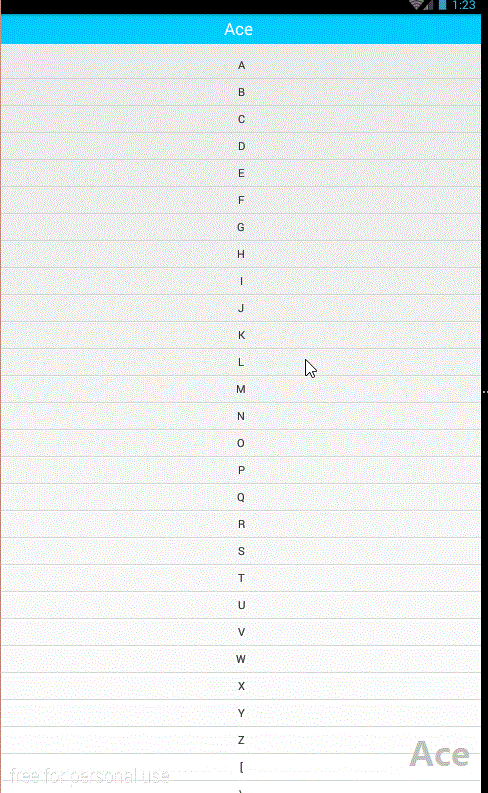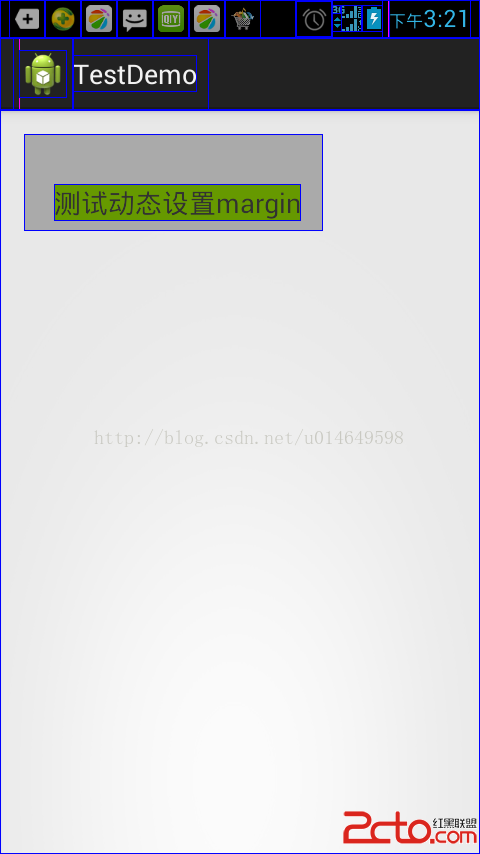編輯:關於Android編程
本文實例嘗試模仿實現Android標題顯示隱藏功能,通過給listview設置 mListView.setOnTouchListener 監聽 重寫ontouch方法 監聽手指一動的坐標,當超過ViewConfiguration.get(this).getScaledTouchSlop(); toubar的高度 .當向上滑動超過這個高度顯示touba 向下滑動隱藏。
效果圖:

package com.example.hidetitlebardemo;
import android.animation.Animator;
import android.animation.ObjectAnimator;
import android.app.Activity;
import android.os.Bundle;
import android.view.MotionEvent;
import android.view.View;
import android.view.Menu;
import android.view.MenuItem;
import android.view.ViewConfiguration;
import android.view.ViewGroup;
import android.view.Window;
import android.widget.AbsListView;
import android.widget.ListView;
import android.widget.RelativeLayout;
import android.widget.SimpleAdapter;
import java.util.ArrayList;
import java.util.HashMap;
import java.util.List;
import java.util.Map;
public class MainActivity extends Activity {
private ListView mListView;
private RelativeLayout mTitle;
private int mTouchSlop;
private SimpleAdapter mAdapter;
private float mFirstY;
private float mCurrentY;
@Override
protected void onCreate(Bundle savedInstanceState) {
super.onCreate(savedInstanceState);
requestWindowFeature(Window.FEATURE_NO_TITLE);
setContentView(R.layout.activity_main);
mTouchSlop = ViewConfiguration.get(this).getScaledTouchSlop();
initViews();
showHideTitleBar(true);
}
private void initViews() {
mListView = (ListView) findViewById(R.id.id_lv);
mTitle = (RelativeLayout) findViewById(R.id.id_title);
mAdapter = new SimpleAdapter(this, getData(),
R.layout.lv_item,
new String[]{"info"},
new int[]{R.id.num_info});
mListView.setAdapter(mAdapter);
mListView.setOnTouchListener(new View.OnTouchListener() {
@Override
public boolean onTouch(View v, MotionEvent event) {
switch (event.getAction()) {
case MotionEvent.ACTION_DOWN:
mFirstY = event.getY();
break;
case MotionEvent.ACTION_MOVE:
mCurrentY = event.getY();
if (mCurrentY - mFirstY > mTouchSlop) {
System.out.println("mtouchislop:" + mTouchSlop);
// 下滑 顯示titleBar
showHideTitleBar(true);
} else if (mFirstY - mCurrentY > mTouchSlop) {
// 上滑 隱藏titleBar
showHideTitleBar(false);
}
break;
case MotionEvent.ACTION_UP:
break;
}
return false;
}
});
}
private Animator mAnimatorTitle;
private Animator mAnimatorContent;
private void showHideTitleBar(boolean tag) {
if (mAnimatorTitle != null && mAnimatorTitle.isRunning()) {
mAnimatorTitle.cancel();
}
if (mAnimatorContent != null && mAnimatorContent.isRunning()) {
mAnimatorContent.cancel();
}
if (tag) {
mAnimatorTitle = ObjectAnimator.ofFloat(mTitle, "translationY", mTitle.getTranslationY(), 0);
mAnimatorContent = ObjectAnimator.ofFloat(mListView, "translationY", mListView.getTranslationY(), getResources().getDimension(R.dimen.title_height));
} else {
mAnimatorTitle = ObjectAnimator.ofFloat(mTitle, "translationY", mTitle.getTranslationY(), -mTitle.getHeight());
mAnimatorContent = ObjectAnimator.ofFloat(mListView, "translationY", mListView.getTranslationY(),0);
}
mAnimatorTitle.start();
mAnimatorContent.start();
}
private List<Map<String, Object>> getData() {
List<Map<String, Object>> data = new ArrayList<>();
for (int i = 'A'; i < 'z'; i++) {
Map<String, Object> map = new HashMap<>();
map.put("info", (char) i);
data.add(map);
}
return data;
}
}
布局
<?xml version="1.0" encoding="utf-8"?> <RelativeLayout android:layout_width="match_parent" android:layout_height="match_parent" android:orientation="vertical" xmlns:android="http://schemas.android.com/apk/res/android"> <RelativeLayout android:id="@+id/id_title" android:background="#00ccff" android:layout_width="match_parent" android:layout_height="40dp"> <TextView android:text="Ace " android:layout_centerInParent="true" android:textSize="22sp" android:textColor="#ffffff" android:layout_width="wrap_content" android:layout_height="wrap_content" /> </RelativeLayout> <ListView android:id="@+id/id_lv" android:layout_width="match_parent" android:layout_height="match_parent"/> </RelativeLayout>
希望本文所述對大家學習Android軟件編程有所幫助。
 Android日志Log
Android日志Log
日志可以在幫我們開發中調試程序,下面看看Android自帶日志的作用先聲明一個字符串 private static final String TAG = &qu
 基於Android移動終端的微型餐飲管理系統的設計與實現2-側滑菜單
基於Android移動終端的微型餐飲管理系統的設計與實現2-側滑菜單
今天我先來寫一下側滑菜單,如圖: 側滑菜單的實現方法有很多,網上也有完整的開源框架,現在如果用Android Studio開發的話,一開始選模板的時候就可以選擇
 Android布局FrameLayout的使用
Android布局FrameLayout的使用
序:本文介紹FrameLayout兩點:1.FrameLayout是什麼 2.FrameLayout如何設置其內子視圖(例如ImageView)的位置。 1. 什麼是Fr
 Android 動態設置margin
Android 動態設置margin
android的view中有setPadding,但是沒有直接的setMargin方法。如果要在代碼中設置該怎麼做呢?可以通過設置view裡面的 LayoutParams